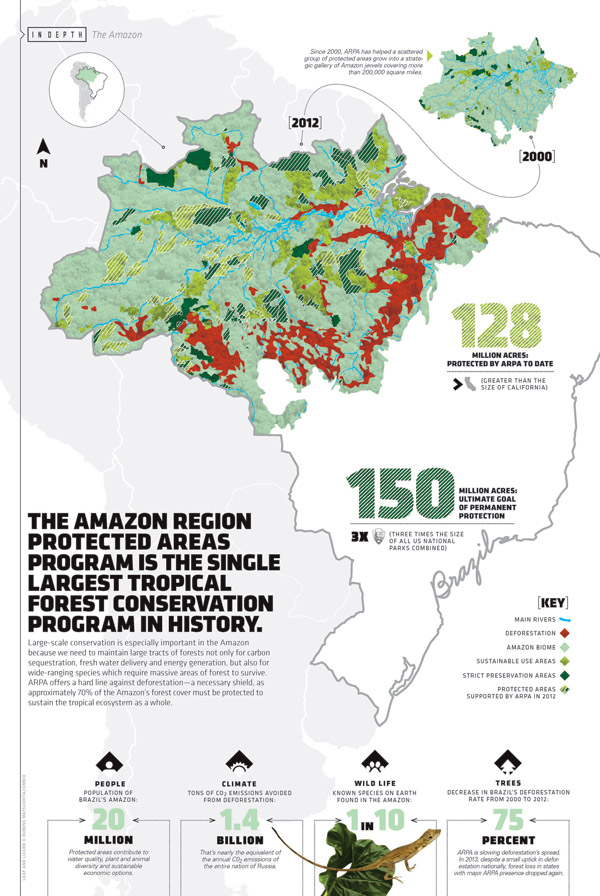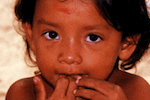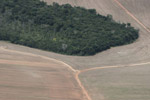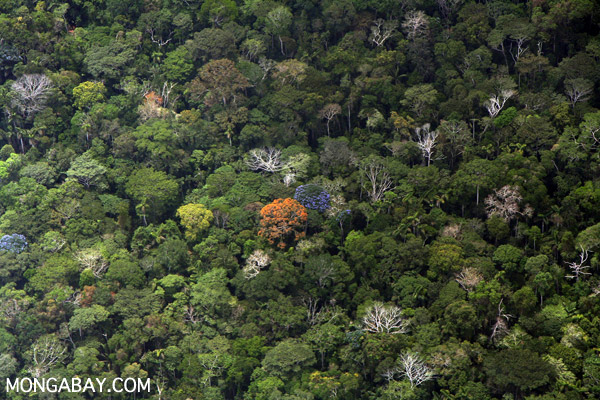By all standards the Amazon Region Protected Areas (ARPA) program is gargantuan: the network includes over 90 parks, covers 51 million hectares, and comprises 15 percent of Brazil’s Amazon. Three times larger than all of the U.S.’s national parks combined, it’s the world’s largest protected area network. But protecting an area bigger than Spain isn’t cheap or easy. Today, a broad coalition of government donors and private funders have announced $215 million to secure ARPA over the next 25 years.
“The explosion in demand for natural resources has made our parks and world heritage sites vulnerable,” said Carter Roberts, president and CEO of World Wildlife Fund (WWF). “So we convened leading financial thinkers and philanthropic partners to create a plan for a first-of-its-kind bridge fund to ensure ARPA’s inspiring success story can be told forever.”
Diverse funders include WWF, the World Bank, the Gordon and Betty Moore Foundation, the Cargill Foundation, the Inter-American Development Bank, and the governments of Germany and Brazil among others (see full list below). Not only will the funds help better protect established parks, but it will also add another 8.9 million hectares of Amazon rainforest to the ARPA program, driving the total to over 60 million hectares.
Aerial view of flowering trees in the Amazon. Photo by: Rhett A. Butler.
ARPA was kickstarted in 2002 as a part of Brazil’s pledge to triple protected in the Amazon rainforest. ARPA has drastically increased the amount of land protected in the Brazilian Amazon—by 23 million hectares—but it also upgraded long-neglected parks and created sustainable-use reserves for local communities and indigenous people. ARPA has also been lauded for helping to slow deforestation in the Brazilian Amazon, one of the major environmental bright spots over the past decade. However, rates jumped last year by 28 percent, a trend some connect to recent changes in Brazil’s Forestry Code though scientists have also put forward several hypotheses.
Still, donors hope that by stepping up they will ensure greater protection and conservation effort for the world’s biggest rainforest. The $215 million will be distributed over the next 25 years, with payments decreasing as the years go on. Future funds will be dependent on Brazil meeting certain conditions. By 2040, funding responsibilities will be returned fully to Brazil.
The impressive haul for a conservation project was achieved by using a method usually reserved for Wall Street, big infrastructure, or expensive industrial projects. Employinh “project finance,” donors committed to an all-or-nothing strategy instead of the usual donor strategy of raising money dollar-by-dollar. This means that all details are agreed on before any money is put forward.and all funds are brought in at the same time.
“We borrowed a page from Wall Street—you build together the capital to fund the whole thing,” Roberts told Bloomberg. “We put together a plan that would help Brazil close the gap over time. It’s all about the art of the deal and having a clear, singular vision.”
Funders say the ARPA model is already being used elsewhere.
“The question of replicating ARPA is no longer a theoretical discussion. Already in Brazil, the ARPA model is being replicated in
the Marine and Coastal Protected Areas project, which aims to increase marine areas under protection by 70 percent. The concepts used in the implementation of ARPA are starting to inspire similar approaches to key ecosystems around the world, such as Africa’s Serengeti,” noted Naoko Ishi, CEO and Chairperson of the Global Environment Facility.
Yet even as Brazil has set aside far more conservation land than any other country over the last decade, it has also stripped protections from a wide swathe. A study earlier this year found that between 1981 and 2012, Brazil took away protection from 5.2 million hectares, an area larger than Costa Rica. The bulk of this was between 2008 and 2012 and much of it linked to large-scale energy projects such as hydroelectric dams.
Brazil’s Ministry of the Environment says the Amazon rainforest currently contains between 10-15 percent of the world’s known species and is home to many indigenous tribes.
“There’s nothing bigger than ARPA. It’s the biggest conservation project of all time,” added Roberts.
ARPA’s donors for the next 25 years:
- Amazon Fund/BNDES
- Brazil Ministry of the Environment
- Brazilian Biodiversity Fund (FUNBIO)
- Brazilian private donors
- Chico Mendes Institute for Biodiversity Conservation
- Federal Ministry for Economic Cooperation and Development of Germany
- Fundação Boticário
- Global Environment Facility
- Gordon and Betty Moore Foundation
- Government of Brazil
- Inter-American Development Bank
- Joseph and Carson Gleberman
- Brazilian private donors
- KfW German Development Bank
- Linden Trust for Conservation
- Margaret A. Cargill Foundation
- Natura
- Redstone Strategy Group
- Roger and Vicki Sant
- State Governments of Brazil: Acre, Amazonas, Amapá, Mato Grosso, Pará, Rondonia and Tocantins
- Wendy and Hank Paulson
- World Wildlife Fund
- World Bank

Map by: WWF. Click to enlarge.
Related articles
Greenpeace: Timber laundering rampant in the Brazilian Amazon

(05/18/2014) A two-year investigation by Greenpeace has revealed the extent of timber laundering in two major Brazilian Amazon states: Pará and Mato Grosso. The report, published last week, suggests that fraud is widespread in the Brazilian timber industry. Loggers are using loopholes and outright deception to game regulations that aim to reduce the environmental impact of timber extraction.
New report reveals human rights abuses by corporations, governments in the Amazon

(05/14/2014) Regnskogfondet (the Rainforest Foundation of Norway) recently released a 52-page report that gives an in-depth account of the conflicts activists and indigenous peoples (IPs) are having with corporations and governmental agencies. It relays a situation that does not look good.
Uncovering the impact of big banks on the Amazon

(05/13/2014) Mongabay.org announces up to $30,000 environmental reporting grant: The Brazilian Development Bank & The Amazon. In recent years the Brazilian Development Bank BNDES as emerged as a goliath financier of large-scale energy and infrastructure development in the Amazon and elsewhere in South America. But as projects have mushroomed across the continent, so have the social and environmental impacts.
Intensifying cattle production in Brazil could cut global deforestation emissions 25%, says study

(04/28/2014) Brazil could reduce more than a quarter of emissions linked to deforestation worldwide by intensifying cattle production in the Amazon, argues a new study published in the journal Proceedings of the National Academy of Sciences.
Next big idea in forest conservation? Crowdsourced forest monitoring

(04/25/2014) In the Brazilian Amazon, deforestation alerts are being submitted via smartphones. On the ground technicians send alerts to a database stored in ‘the cloud.’ This information is added to maps, which, along with satellite imagery, are used to inform law enforcement. And the speed of this process is getting real results.
Brazil’s new Forest Code a mixed bag for native ecosystems
(04/24/2014) The revised Forest Code passed into law by Brazil in 2012 could authorize conversion of 400,000 square miles of native grassland for industrial agriculture, while granting amnesty for deforesters in the Amazon rainforest, argues a policy piece published this week in the journal Science.
Brazil to test drones in monitoring the Amazon rainforest
(04/24/2014) Brazilian municipalities are planning to use drones to map properties and monitor forest cover as they move to step up enforcement of the country’s Forest Code, reports The Financial Times.
Brazil strips protected status from 5.2M ha
(04/21/2014) While Brazil led the world in establishing new protected areas in recent years, it has also stripped legal protected status from some 5.2 million hectares (12.8 million acres) of land, finds a new study published in the journal Conservation Biology.
Nearly a thousand environmental activists murdered since 2002

(04/15/2014) At least 908 people were murdered for taking a stand to defend the environment between 2002 and 2013, according to a new report today from Global Witness, which shows a dramatic uptick in the murder rate during the past four years. Notably, the report appears on the same day that another NGO, Survival International, released a video of a gunman terrorizing a Guarani indigenous community in Brazil.
